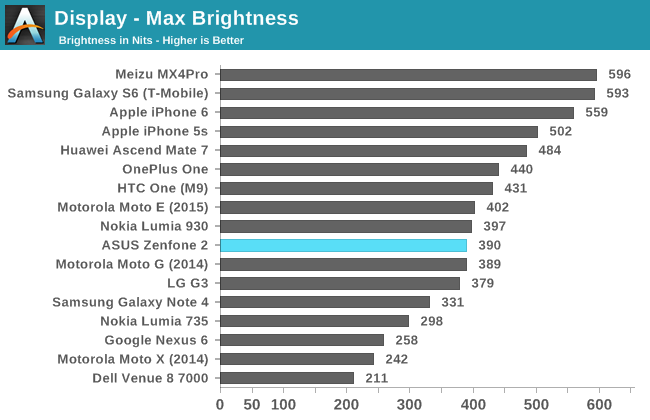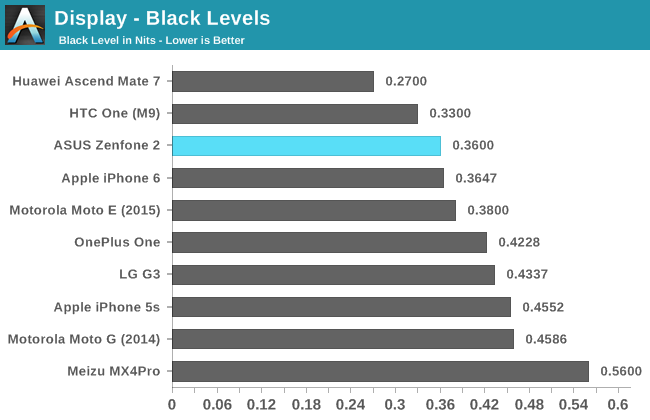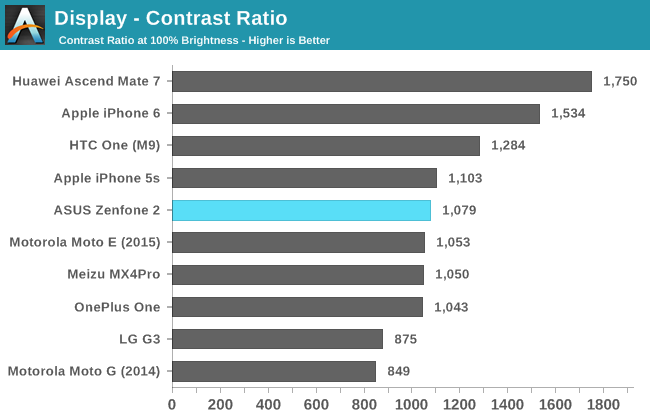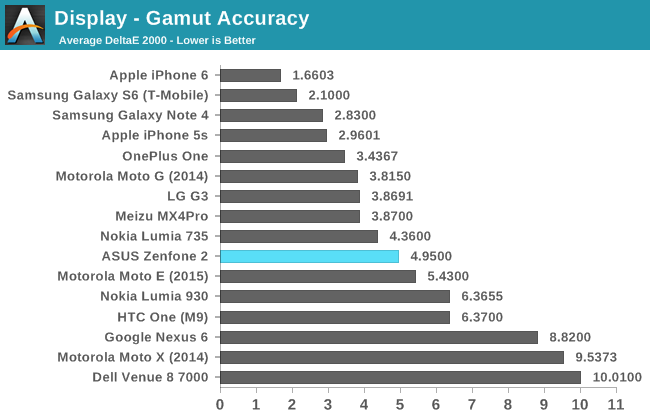The ASUS ZenFone 2 Preview
by Brandon Chester on May 18, 2015 2:00 PM ESTDisplay
I thought it would be important to give potential buyers some idea of how good the display is on the ZenFone 2. On paper it looks very good, as it's a 5.5" 1920x1080 IPS display. The pixel density isn't as high as the latest generation of 2560x1440 panels, but I find that with an RGB stripe panel the difference between 1920x1080 and 2560x1440 is minimal even at 5.5".


The ZenFone 2 appears to be off to a good start. Black levels are very low among our LCDs, and the max brightness is somewhat low but not terrible by any means. I never had any issues when using the ZenFone 2 outside, although it was definitely not as comfortable as the Galaxy S6.

The slightly low max brightness and above average black level results put the ZenFone 2 right in the middle of our LCD devices when it comes to contrast ratio.
Unfortunately, these numbers are somewhat misleading. This is because the ZenFone 2 makes extremely heavy use of dynamic contrast and contect adaptive backlighting. I have never used another device with such dramatic shifts in backlight power. The best example I've found is when switching from an all black to all white screen at max brightness. While this is obviously an extreme case, it illustrates the behavior that is occuring very well. At the moment you switch to white, the brightness of the display is around 170 nits. Over the next few seconds, that brightness rapidly increases to the 390 nits you see in the results above. This is an enormous jump in brightness, and it's very easy to see with your own eyes.
One last thing I'd like to note about the brightness is that the 100% setting on the built in brightness slider is not actually the max brightness that the display is capable of. The max you can achieve using the slider in the Settings app is 319 nits, which is around 82% of the 390 nit result you can get using applications like Brightness Adjuster from Google Play.

The gamut results are unfortunately not as good as what we've seen from the latest generation of smartphones. The DeltaE for red, blue, and magenta are all just over three, while the remaining three colors are around five. The high error in white also contributes to the higher than optimal overall error.
The complete review of the ZenFone 2 should be posted in the near future, and it will include the remainder of our display workflow. The heavy use of CABC and dynamic contrast has a large impact on the display's performance in some of our tests, and so I'll also be elaborating on where and why that occurs, and what it means for the user. For anyone who really wants to order the ZenFone 2 now, I'll conclude by saying that it's definitely not perfect, but it's still a good display. I think it's by far the nicest one you'll find on a phone that starts at $199 purely because of its resolution.











139 Comments
View All Comments
blzd - Thursday, May 21, 2015 - link
Hahahaha. Oh man. The fact that these manufacturers are spending large sums of their money to actually make Android WORSE in every possible way (Touchwiz, etc.) and waste our storage space with bloat apps that are inferior to the stock Android implementation (Asus browser lol) still baffles me.If stock Android looks better, runs better, and is less confusing than your UI and bloatware then you're doing it wrong.
pierrot - Monday, May 18, 2015 - link
I remember reading someplace that tablets using PowerVR wouldnt/couldnt get custom ROMs developed. Does that hold true for these as well? That would be a real shame to be at the mercy of ASUS for OS updates.Daniel Egger - Monday, May 18, 2015 - link
The major downside of Intel devices is that they're really locked down with that annoying security stuff so there's very little one can do to get an alternative OS or at least a more optimized Android onto those devices and if the vendor decides to not provide OS updates then you'll either have to get a new device or live with the security breaches piling up. I happen to have an Asus device with Intel CPU and I'm stuck with the horrible inefficient KitKat and abysmal battery life until (and only if) Asus decides to pull the stick out of their backsides and provide a Lollipop update -- at least some of the bloatware can be disabled thanks to an exploitable bug in their demo application.At the moment I'm really less than thrilled by the idea of having another Intel based Android device; luckily I've just gotten a new phone and thanks to a Qualcomm processor and an unlocked bootloader it's going to have a really long life...
Speedfriend - Tuesday, May 19, 2015 - link
I bought a cheap Asus Intel powered tablet for under $100 on a deal and it is brillant for the price. Great battery life, smooth, all apps work. I wouldn't hesitate to buy another.Daniel Egger - Tuesday, May 19, 2015 - link
Me too, a ME176C. However despite it's crunching power it's rather sluggish, some apps don't run properly (thanks to the Intel CPU I'd guess) and some of the ZenUI apps tend to evict current foreground applications out of memory which makes for a horrible browsing experience. Also the battery used to be good for only 2 hours of ebook reading and after disabling lots of crap it has improved to over 4 hours (GPS and WiFi disabled and on lowest brightness) -- according to CPUSpy I managed to make it deep sleep regularly which is a good thing.I think with a proper CyanogenMod 12.1 ROM this might be a crazy good device but with the KitKat based Asus ZenUI ROM and the energy hungry Intel CPU it's not really a good device for untethered operation.
Zentastic - Friday, May 22, 2015 - link
Well you dont need the CyanogenMod,Lollipop is on the way for all of Asus tablets that came out in 2014.ME572 already has 5.0.1,and soon the rest of their lineup will get 5.0 and above(ME176,ME70,ME181,FE170 etc)Zentastic - Friday, May 22, 2015 - link
And problem with ME176C is not the Intel procesor(per se),it's the Intel graphic card.Brakken - Monday, May 18, 2015 - link
Why the iPh6 and not the 6+? Screen sizes are even the same!I'm glad Asus and Intel have teamed up. I really hope they continue to develop their partnership!
tipoo - Monday, May 18, 2015 - link
Develop? It's longstanding. one of the reasons Asus is going against the grain putting Intel in phones is that pre-existing relationship.The other reason being Intel is practically giving them for free, lol. 5 dollars after the contra-revenue program, so I hear.
testbug00 - Tuesday, May 19, 2015 - link
well, the cost is about free. The extra stuff you get that's totally not related to the Atom's you bought...